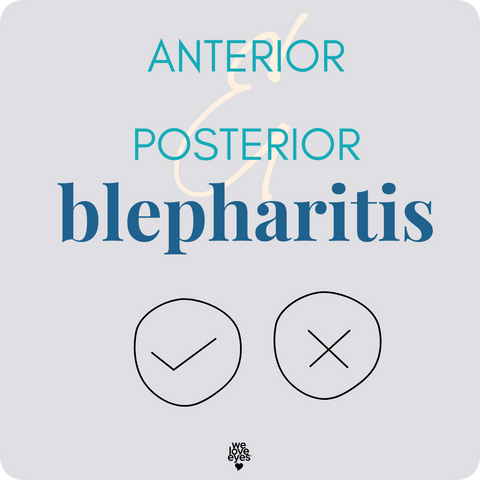Anterior vs. Posterior BLEPHARITIS: Visual Examples and Key Differences

Show Me Picture Examples of ANTERIOR and POSTERIOR BLEPHARITIS
BLEPHARITIS is one of the most common eyelid conditions I see. It can present along the front edge of the eyelid—known as ANTERIOR BLEPHARITIS—or deeper at the level of the meibomian glands, termed POSTERIOR BLEPHARITIS (aka Meibomian Gland Dysfunction, MGD). Below are photos to help you visualize the differences. It's about the real estate. LOCATION. LOCATION. LOCATION.
Example of ANTERIOR BLEPHARITIS

In anterior disease, you’ll notice crusting, flaky debris, and small white scales clinging to the eyelashes. The visible irritation sits right at the eyelash base.
An example of ANTERIOR BLEPHARITIS: flaky scales and crust at the eyelid margin. Note the flakey debris along the eyelid margin but RIGHT at the eyelashes.
Example of POSTERIOR BLEPHARITIS

Posterior blepharitis involves inflammation of the meibomian glands behind the eyelid. You may see plugged gland orifices, turbid secretions, and redness along the inner margin of the lid.
An example of POSTERIOR BLEPHARITIS: inflamed meibomian gland orifices with plugging and hyperemia (redness) of the eyelid margin.
Key Differences Between Anterior and Posterior BLEPHARITIS
- Location: ANTERIOR BLEPHARITIS affects the eyelash base and eyelid skin surface. POSTERIOR BLEPHARITIS centers on the meibomian gland openings right on the eyelid margin.
- Signs: Look for crusts, collarettes, or dandruff‐like scales in ANTERIOR BLEPHARITIS cases. In POSTERIOR BLEPHARITIS disease, you’ll see meibomian gland plugging, thickened oil (called meibum), and telangiectasia (tiny red blood vessels) along that eyelid margin.
- Symptoms: Both can cause irritation, burning, and redness - that's why it's often confusing. POSTERIOR BLEPHARITIS cases often lead to tear film instability and evaporative dry eye due to compromised lipid (oil) secretion.
How to Manage Both Types of BLEPHARITIS
For ANTERIOR BLEPHARITIS, I recommend daily lid hygiene with a gentle foaming cleanser. Warm compresses help loosen crusts so you can gently scrub debris away. See Anterior Blepharitis Cleansing System. If there is a bacterial component involved, your optometrist will likely prescribe an antibiotic eye drop or antibiotic eye ointment.
In POSTERIOR BLEPHARITIS, you need to soften and express meibomian gland secretions. Warm compresses followed by a light lid massage can help. See Posterior Blepharitis Cleansing System. In‐office treatments like meibomian gland expression or energy therapies may also be indicated.
For patients with both ANTERIOR & POSTERIOR BLEPHARITIS - I start with my Posterior Blepharitis Cleansing System and add the Calm Eyelid & Eyelash Cleansing Spray for the final step.
Addressing either of BLEPHARITIS promptly prevents chronic irritation and helps maintain a healthy tear film.

Hi, I’m Dr. Tanya Gill, optometrist and founder of We Love Eyes. I started We Love Eyes in 2014 while trying to help one of my (stubborn) patients with contact lens discomfort. In 2016, I had 3 products. Fast forward to today - We Love Eyes has almost 30 SKUs. It’s been an amazing journey. Explore my life’s work at weloveeyes.com. Check out my BLEPHARITIS COLLECTION section to find healthy eye care products for your eye problem. I also have a ton of content at TIKTOK. See the profile page and see the playlist BLEPHARITIS. xo
-
BLEPHARITIS
-
ANTERIOR BLEPHARITIS - see the tutorial blog here
-
POSTERIOR BLEPHARITIS - see the tutorial blog here
- We Love Eyes BLEPHARITIS guide - SHOP Blepharitis Collection
-
eyelid margin inflammation
-
meibomian gland dysfunction
-
lid hygiene tips
-
warm compress routine
-
Dr. Tanya Gill blepharitis care
-
ocular surface health

